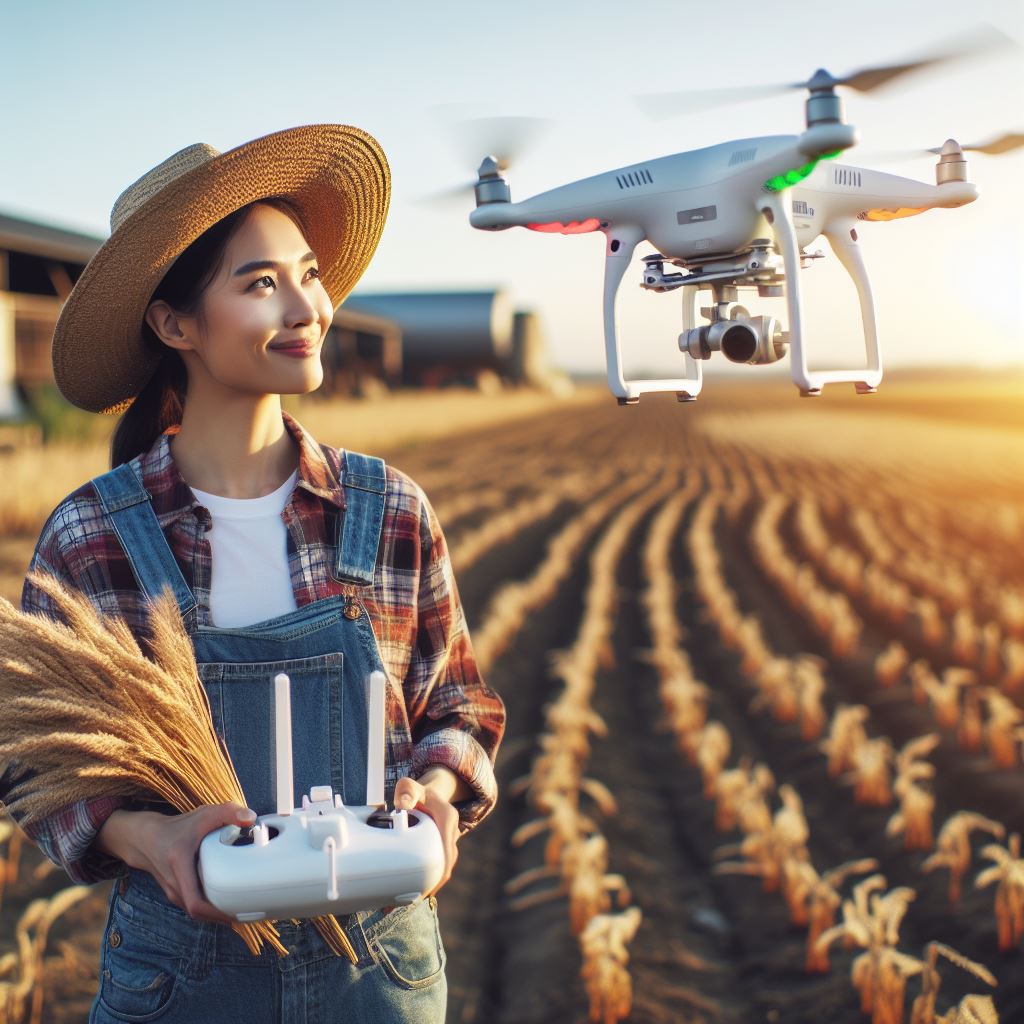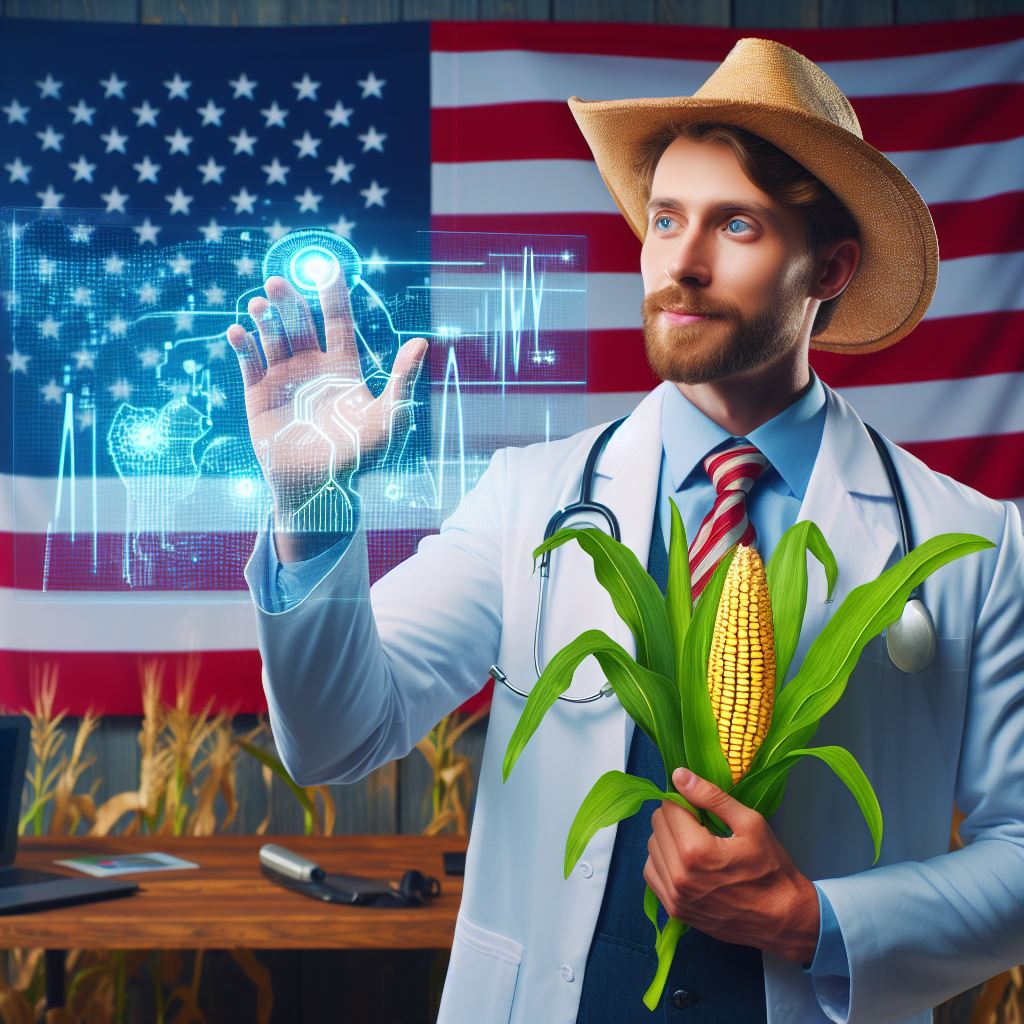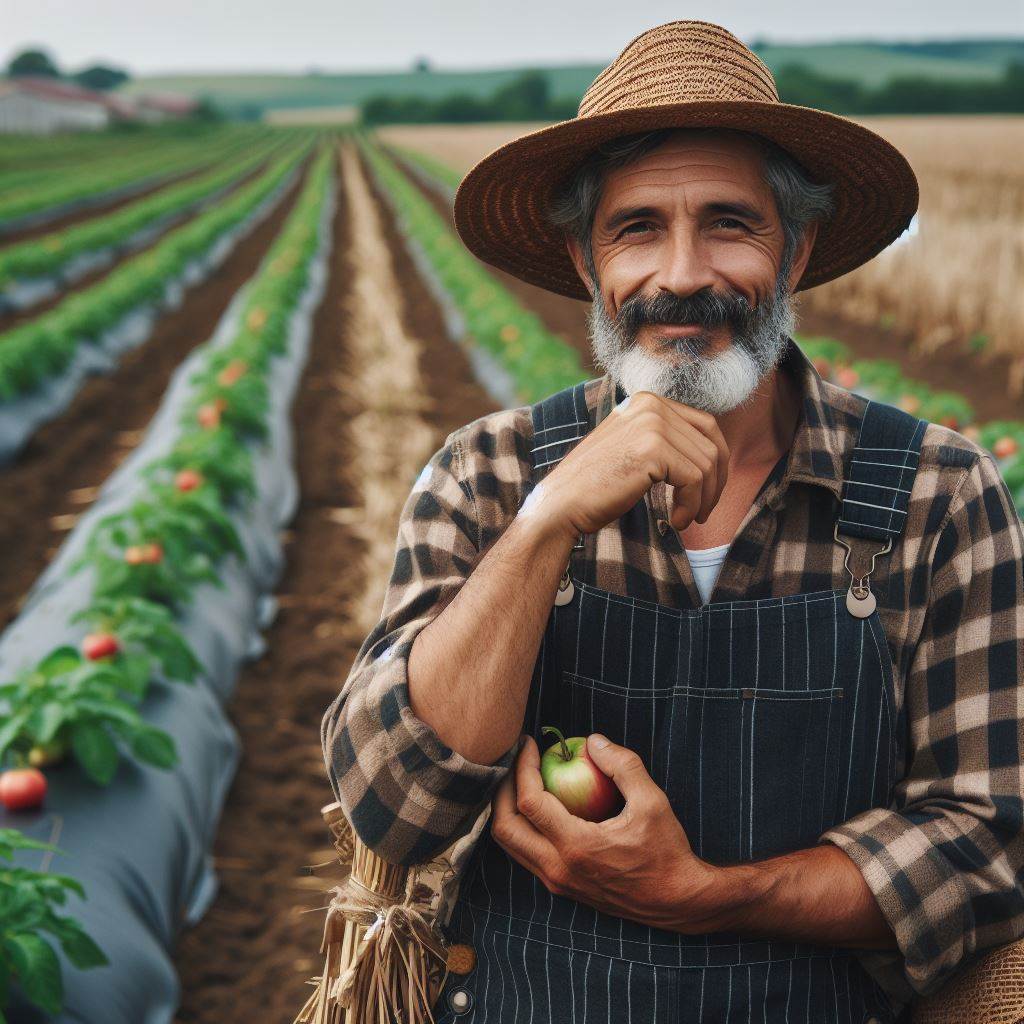Introduction
Definition of drones in agriculture
Drones have revolutionized the agricultural sector, contributing to significant changes in farming dynamics.
These unmanned aerial vehicles, commonly known as drones, have become an essential tool for farmers.
They have proven to be highly valuable in optimizing various farming tasks, ultimately enhancing overall efficiency and productivity.
Drones in agriculture refer to the use of unmanned aerial vehicles to perform a wide range of farm-related activities.
These activities include but are not limited to crop monitoring, crop spraying, precision agriculture, livestock monitoring, and soil analysis.
With the ability to carry out these tasks efficiently, drones have undoubtedly transformed the way farming is conducted.
Importance of drones in improving farming dynamics
The importance of drones in improving farming dynamics cannot be overstated.
Firstly, drones enable farmers to gather real-time data and monitor crop health and growth.
Equipped with high-resolution cameras and sensors, these devices provide precise insights into crop conditions.
The collected data helps farmers identify areas that require immediate attention, such as disease or nutrient deficiencies, allowing for timely intervention.
Moreover, drones facilitate efficient crop spraying.
Traditional crop spraying methods are often time-consuming and require considerable resources.
Drones equipped with spraying systems can cover a large field area quickly and evenly distribute pesticides or fertilizers.
This not only saves time but also reduces excessive chemical usage, making farming practices more sustainable.
Drones also enhance precision agriculture by enabling farmers to focus on specific areas that require intervention.
Transform Your Agribusiness
Unlock your farm's potential with expert advice tailored to your needs. Get actionable steps that drive real results.
Get StartedThe ability to deliver targeted treatments, such as applying fertilizer or pesticides only where needed, leads to optimal resource utilization while minimizing waste.
This not only reduces costs for farmers but also has positive environmental impacts.
Basically, drones in agriculture have become indispensable in improving farming dynamics.
From crop monitoring to precision agriculture, these unmanned aerial vehicles offer immense potential to increase efficiency, productivity, and sustainability in the agricultural sector.
Embracing this technology is crucial for farmers to stay competitive and meet the growing demands of a rapidly changing world.
Benefits of drones in agriculture
Drones have revolutionized various industries, and agriculture is no exception.
With the advancements in technology, drones are increasingly being utilized to improve farming dynamics.
The benefits that drones bring to agriculture are undeniable, making them an essential tool for modern farmers.
Precision agriculture
One of the significant advantages of drones in agriculture is precision farming.
Drones equipped with sensors and imaging capabilities enable farmers to monitor the health of their crops more efficiently.
These sensors provide real-time data on crop conditions, allowing farmers to identify potential issues promptly.
In addition, drones aid in the accurate and timely application of fertilizers and pesticides.
By flying over the fields, drones can precisely target areas that require treatment, reducing the overall usage of chemicals and minimizing environmental impact.
Crop scouting and monitoring
Drones play a crucial role in crop scouting and monitoring.
By flying over the fields, drones can quickly identify pests and diseases that may be affecting the crops.
This early detection enables farmers to take necessary preventive measures, preventing potential crop damage and losses.
Moreover, drones equipped with high-resolution cameras can capture detailed images of the crops, providing farmers with valuable information on their growth and development.
These images can help in identifying any signs of stress, nutrient deficiencies, or other issues, allowing farmers to address them promptly.
Irrigation management
Efficient irrigation management is vital for optimizing crop growth while conserving water resources.
Drones equipped with sensors can monitor soil moisture levels, providing farmers with accurate data on the irrigation requirements of different areas within their fields.
This targeted irrigation approach ensures that crops receive adequate water without unnecessary wastage.
By utilizing drones for irrigation management, farmers can significantly reduce water usage and improve overall water efficiency.
This not only benefits the environment but also helps farmers save on irrigation costs.
Generally, the integration of drones in agriculture brings immense benefits to farmers and the industry as a whole.
Showcase Your Farming Business
Publish your professional farming services profile on our blog for a one-time fee of $200 and reach a dedicated audience of farmers and agribusiness owners.
Publish Your ProfilePrecision agriculture, crop scouting and monitoring, and irrigation management are just a few of the advantages that drones offer.
With their ability to provide real-time data, drones empower farmers to make informed decisions, increase productivity, and minimize environmental impact.
It is clear that drones are changing the farming dynamics and have become an indispensable tool for the modern farmer.
Read: Elevating Agriculture with Drone Innovations
Cost savings and increased efficiency
Drones in agriculture have brought about significant changes in farming dynamics.
Apart from their ability to provide valuable data and insights to farmers, they also offer cost savings and increased efficiency.
Reduction in labor costs
One of the major advantages of using drones in agriculture is the reduction in labor costs.
Drones are capable of covering larger areas in less time compared to manual labor.
This allows farmers to allocate their workforce to other important tasks, saving both time and money.
In addition, drones can automate tasks such as crop spraying, eliminating the need for human workers to physically carry out these operations.
This reduces labor costs and also ensures precision in the application of pesticides or fertilizers.
Improved resource allocation
Furthermore, drones contribute to improved resource allocation on farms.
With their aerial capabilities, drones can quickly identify areas requiring immediate attention, such as those affected by pests or diseases.
This allows farmers to take swift action and prevent further damage, leading to better crop health and higher yields.
Moreover, drones equipped with advanced sensors and imaging technology can provide valuable data on soil moisture levels and nutrient distribution.
By analyzing this data, farmers can optimize the use of inputs such as water and fertilizers, avoiding wastage and reducing costs.
Essentially, the use of drones in agriculture offers significant cost savings and increased efficiency.
The ability to cover larger areas in less time, coupled with the automation of tasks such as crop spraying, reduces the dependency on manual labor and its associated costs.
Additionally, drones aid in the better allocation of resources by identifying areas requiring immediate attention and optimizing inputs like water and fertilizers.
With these benefits, drones are revolutionizing farming practices and changing the dynamics of the agricultural industry.
Read: Drone Tech in Agriculture: A Deep Dive
Case studies and success stories
Drones in agriculture have not only gained popularity but also proven to be highly beneficial in changing farming dynamics.
Real-life examples and success stories from various regions showcase the incredible impact of drones in this industry.
Real-life examples of drones in agriculture
Increased crop yields and quality
In a study conducted in California, drones equipped with multispectral cameras were used to monitor crop health, leading to a significant increase in crop yields.
The drones helped identify stressed plants, allowing farmers to take immediate action and prevent crop loss.
This resulted in higher-quality produce and improved profitability.
Reduced use of chemicals and environmental impact
Drones have also played a vital role in reducing the need for harmful chemicals in agriculture.
Intelligent drones equipped with advanced technology can accurately target pests and diseases, minimizing the use of pesticides.
This not only ensures safer produce but also reduces the environmental impact associated with traditional farming methods.
Testimonials from farmers and industry experts
Positive feedback on the effectiveness of drones in agriculture
Farmers who have integrated drones into their farming practices express overwhelming satisfaction with the results.
With drones, they can now monitor their crops more efficiently, detect irrigation issues, and identify nutrient deficiencies.
This real-time data enables them to make timely decisions, resulting in increased productivity and higher crop quality.
Demonstrated improvements in farming practices
Industry experts believe that drones have revolutionized the way farming is conducted.
The ability to capture aerial images and perform advanced analytics helps farmers optimize water and fertilizer usage.
Drones also aid in the detection of crop diseases and allow for precise application of treatments, saving time and resources.
These improvements lead to more sustainable and efficient agricultural practices.
The success stories and testimonials underscore the transformative power of drones in agriculture.
Increased crop yields, improved crop quality, reduced chemical usage, and enhanced farming practices are just a few examples of the numerous benefits drones bring to the agricultural sector.
Moreover, the integration of drones into agriculture is not limited to large-scale farms.
Small-scale farmers also report positive outcomes.
Showcase Your Farming Business
Publish your professional farming services profile on our blog for a one-time fee of $200 and reach a dedicated audience of farmers and agribusiness owners.
Publish Your ProfileDrones provide affordable and accessible technology that empowers farmers to overcome challenges and maximize their profits.
In general, drones in agriculture have proven to be effective tools in changing farming dynamics.
Real-life examples highlight increased crop yields, improved crop quality, and a reduced environmental impact.
Farmers and industry experts speak highly of the positive outcomes and improvements in farming practices brought about by drones.
As technology continues to advance, the role of drones in agriculture is expected to expand further, making them indispensable for farmers worldwide.
Read: Sky Farming: Drones and Their Impact

Challenges and Limitations
Drones have emerged as a valuable tool in the agricultural sector, revolutionizing traditional farming practices.
However, their adoption also comes with several challenges and limitations that need to be addressed to fully capitalize on their potential.
Regulatory Issues and Legal Considerations
- Compliance with local aviation regulations: Drones are subject to aviation regulations imposed by local authorities. These regulations may include restrictions on flight altitude, flying in certain areas, and obtaining licenses or permits. Farmers and drone operators need to ensure compliance to avoid legal consequences.
- Privacy concerns and data protection: Drones equipped with cameras and sensors can collect vast amounts of data during agricultural operations. This data may include sensitive information about crops, livestock, and farm infrastructure. Protecting this data from unauthorized access and ensuring privacy rights of individuals becomes crucial.
Technical Limitations
- Battery life and flight time restrictions: Most agricultural tasks require extensive coverage of large areas, necessitating drones to have long flight durations. However, battery life limitations pose a challenge as drones typically have a limited flight time before they need to be grounded for recharging. This limitation hinders their continuous operation and efficiency.
- Limited payload capacity for certain tasks: Some agricultural operations may require drones to carry heavy equipment, pesticides, or fertilizers. However, drones currently have limited payload capacity, making it difficult to accomplish such tasks efficiently. The need for larger payload capacities remains a technical limitation that needs to be addressed.
Overcoming These Challenges
To overcome these challenges and limitations, proactive measures can be taken:
- Collaboration with regulatory authorities: Farmers and drone operators should engage with local aviation authorities to understand and facilitate compliance with regulations. This could involve obtaining necessary permits, licenses, and adhering to guidelines imposed by regulatory bodies.
- Data encryption and secure storage: Implementing robust data encryption techniques and secure storage systems can ensure the protection of sensitive agricultural data. This would discourage unauthorized access and safeguard privacy rights.
- Research and development for better battery life: Investment in research and development aimed at enhancing battery life is crucial. Longer flight durations would improve the coverage and capability of drones, making them more effective in agricultural operations.
- Advancements in drone technology: Continued innovation in drone engineering must focus on increasing payload capacity, allowing drones to carry larger and heavier payloads. This would enable the use of drones in a wider range of agricultural tasks, facilitating more efficient and effective farming practices.
In essence, while drones offer immense potential for improving farming dynamics, challenges and limitations need to be addressed.
Regulatory compliance, privacy concerns, battery life, and payload capacity are crucial areas that require attention.
Collaborative efforts between farmers, drone manufacturers, and regulatory bodies can pave the way for a successful integration of drones in agriculture, revolutionizing the industry for years to come.
Read: Agri Drones: From Planting to Harvesting
Future applications and advancements
Integration of artificial intelligence and machine learning
Improved crop analytics and decision-making
The integration of artificial intelligence and machine learning in drones can enhance crop analytics by analyzing data such as soil health, moisture levels, and temperature.
This allows farmers to make informed decisions regarding irrigation, fertilization, and pest management.
Predictive models for yield estimation and disease outbreaks
By utilizing artificial intelligence and machine learning algorithms, drones can collect extensive data on crops and environmental conditions.
This data can be analyzed to create predictive models that estimate future yields and identify potential disease outbreaks.
Such information enables farmers to take proactive measures to mitigate risks and optimize crop production.
Swarm technology and autonomous systems
Collaborative drones for increased efficiency
Swarm technology involves coordinating a group of drones to work collaboratively on a task.
This approach can greatly improve efficiency in agriculture by enabling drones to perform various operations simultaneously, such as pesticide spraying, crop monitoring, and irrigation.
Collaborative drones can cover larger areas in shorter timeframes, providing farmers with enhanced productivity.
Automation of complex farming tasks
Autonomous systems in drones have the potential to automate complex farming tasks that traditionally required manual labor.
For instance, drones equipped with AI and computer vision can autonomously detect and remove weeds, eliminating the need for on-ground labor.
This reduces costs, saves time, and improves overall efficiency in farm operations.
In a nutshell, the integration of artificial intelligence and machine learning in drone technology opens up promising opportunities for the future of agriculture.
Improved crop analytics, predictive modeling, swarm technology, and autonomous systems are just a few examples of how drones can revolutionize farming dynamics.
By leveraging these advancements, farmers can enhance productivity, optimize resource allocation, and mitigate risks, ultimately leading to sustainable and efficient agriculture.
As the agricultural sector continues to evolve, drones will play a vital role in transforming traditional farming practices into smart and data-driven operations.
Conclusion
Recap of the benefits of drones in agriculture
Drones are revolutionizing agriculture.
They enable farmers to monitor crops, spray precisely, and improve efficiency.
Drones provide aerial imagery for early disease detection, assessing crop health, and planning fertilizer applications.
Their bird’s-eye view captures data undetectable from the ground.
Drones also enable safe, targeted spraying, reducing chemical usage.
By spraying only affected areas, farmers minimize environmental impact.
With sophisticated sensors and AI, drones may someday autonomously survey fields and treat crops.
The benefits of agricultural drones are clear.
They reduce costs and improve productivity.
Drones optimize inputs like water, fertilizer, and pesticides.
Farmers gain insights into their fields, enabling data-driven decisions.
Drones take over dull, dangerous tasks, freeing up farmers’ time.
Showcase Your Farming Business
Publish your professional farming services profile on our blog for a one-time fee of $200 and reach a dedicated audience of farmers and agribusiness owners.
Publish Your ProfileAgricultural drones have already become indispensable tools.
Their potential will only grow as the technology advances.
Encouragement for farmers to embrace drone technology
Farmers should embrace drone technology to remain competitive.
With proper training, drones are safe and reliable.
The long-term benefits far outweigh any short-term costs.
Drones are the future of smart, sustainable agriculture.
Farmers who integrate drones today will reap rewards tomorrow.
Agricultural drones have only scratched the surface of their possible impacts.
As camera and sensor technology improves, drones will provide even richer data to inform farming decisions.
Autonomous drones may take over routine field tasks.
With ongoing innovation, drones will open new possibilities for efficient, productive agriculture.
The future of farming is unmanned.




